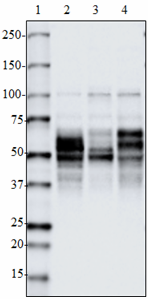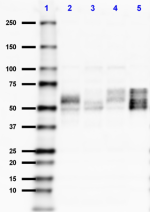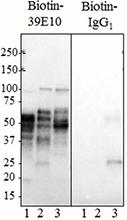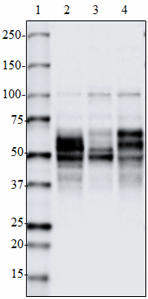- Clone
- 39E10 (See other available formats)
- Regulatory Status
- RUO
- Other Names
- Microtubule-associated protein tau, PHF-tau, Paired Helical Filament tau
- Isotype
- Mouse IgG1, κ
- Ave. Rating
- Submit a Review
- Product Citations
- publications

-

Western blot of HRP anti-Tau, 189-195 antibody (clone 39E10). Lane 1: Molecular weight marker; Lane 2: 20 µg of normal human brain lysate; Lane 3: 20 µg of mouse brain lysate; Lane 4: 20 µg of rat brain lysate. The blot was incubated with 1.0 µg/mL of the primary antibody overnight at 4°C. Enhanced chemiluminescence (Cat. No. 426302) was used as the detection system.
| Cat # | Size | Price | Quantity Check Availability | Save | ||
|---|---|---|---|---|---|---|
| 814306 | 100 µg | $311 | ||||
Tau proteins are microtubule-associated protein (MAPs) which are abundant in neurons of the central nervous system, but are also expressed at very low levels in CNS astrocytes and oligodendrocytes and elsewhere. One of tau's main functions is to modulate the stability of axonal microtubules. Tau is active primarily in the distal portions of axons providing microtubule stabilization as well as flexibility. Pathologies and dementias of the nervous system such as Alzheimer's disease feature tau proteins that have become defective and no longer stabilize microtubules properly. As a result, tau forms aggregates with specific structural properties referred to as Paired Helical Filaments (PHFs) that are a characteristic of many different types of dementias, known as tauopathies.
Product DetailsProduct Details
- Verified Reactivity
- Human, Mouse, Rat
- Antibody Type
- Monoclonal
- Host Species
- Mouse
- Immunogen
- This monoclonal antibody was raised against full-length human tau.
- Formulation
- This antibody is provided in 50% glycerol in aqueous buffered solutions with preservatives.
- Preparation
- The antibody was purified by affinity chromatography and conjugated with HRP under optimal conditions.
- Concentration
- 0.5 mg/ml
- Storage & Handling
- Upon receipt, the antibody solution should be stored undiluted at -20°C, and protected from prolonged exposure to light.
- Application
-
WB - Quality tested
- Recommended Usage
-
Each lot of this antibody is quality control tested by Western blotting. For Western blotting, the suggested use of this reagent is 0.2 - 1.0 µg per ml. It is recommended that the reagent be titrated for optimal performance for each application.
- Application Notes
-
This antibody is effective in immunoblotting (WB).
BioLegend is the Exclusive Provider of this Antibody Product -
Application References
(PubMed link indicates BioLegend citation) -
- Michalski V, et.al. Neurobiol Aging. 2015. 36(12):3131. (WB) PubMed
- Product Citations
-
- RRID
-
AB_2734569 (BioLegend Cat. No. 814306)
Antigen Details
- Structure
- Unmodified Tau isoforms have an apparent molecular weight ranging from 33-79 kD. Additional high and low molecular weight Tau species have been observed in brain tissues.
- Distribution
-
Tissue distribution: Central nervous system, peripheral ganglia and nerves, kidney, skeletal, and heart muscle.
Cellular distribution: Cytoskeleton, nucleus, plasma membrane, and cytosol. - Function
- Tau promotes microtubule assembly and stability. The short tau isoforms allow plasticity of the cytoskeleton whereas the longer isoforms may preferentially play a role in its stabilization.
- Interaction
- Tau interacts with: Sequestosome-1, Peptidyl-prolyl cis-trans isomerase FKBP4, Casein kinase I isoform delta, Serine/threonine-protein kinase Sgk1, Laforin, and alpha-synuclein.
- Biology Area
- Cell Biology, Neurodegeneration, Neuroscience, Protein Misfolding and Aggregation
- Molecular Family
- Tau
- Gene ID
- 4137 View all products for this Gene ID
- UniProt
- View information about Tau 189-195 on UniProt.org
Related FAQs
Other Formats
View All Tau, 189-195 Reagents Request Custom Conjugation| Description | Clone | Applications |
|---|---|---|
| Purified anti-Tau, 189-195 | 39E10 | WB |
| Biotin anti-Tau, 189-195 | 39E10 | WB,Direct ELISA |
| HRP anti-Tau, 189-195 | 39E10 | WB |
Compare Data Across All Formats
This data display is provided for general comparisons between formats.
Your actual data may vary due to variations in samples, target cells, instruments and their settings, staining conditions, and other factors.
If you need assistance with selecting the best format contact our expert technical support team.
-
Purified anti-Tau, 189-195

Western blot of purified anti-Tau, 189-195 antibody (clone 3... -
Biotin anti-Tau, 189-195

Western blot of biotin anti-Tau, 189-195 antibody (clone 39E... 
Direct ELISA of biotin anti-Tau, 189-195 antibody (clone 39E... -
HRP anti-Tau, 189-195

Western blot of HRP anti-Tau, 189-195 antibody (clone 39E10)...
 Login/Register
Login/Register 







Follow Us